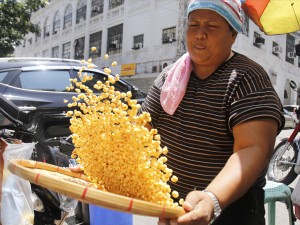
INFLATION SLOWDOWN A woman vendor tosses cornick, a Filipino variant of corn nuts, in the air to clean away small parts in downtown Manila on Monday, Sept. 5, 2011. Low prices of food, among others, have contributed to the slowing of the Philippines’ annual inflation to a four-month low of 4.3 percent in August. AP Photo/Aaron Favila
The annual inflation rate slowed to a four-month low in August, boosting prospects that monetary authorities will keep interest rates at low levels.
Annual headline inflation in August was 4.3 percent, based on year 2000 prices, a notch lower than market forecasts and near the lower end of a central bank estimate.
It averaged 4.3 percent in the eight months to August, well inside a Bangko Sentral ng Pilipinas (BSP) target of 3 to 5 percent for the year. A new series based on 2006 prices, which will become the standard measure next year, put annual inflation at 4.7 percent, slowing from 5.1 percent in July and bringing the eight-month average to 4.8 percent.
The National Statistics Office (NSO) reported Tuesday that based on 2006 prices, the rate of increase slowed down for food and non-alcoholic beverages; clothing and footwear; housing; water; electricity, gas and other fuels; recreation and culture; and education.
Economists said the lower inflation rate was to be expected since there were no sharp changes in food, fuel, light and water prices given the slow-moving economy and uncertainties on future economic growth worldwide. Economists also said the tamer inflation rate lessened worries on interest rates and could spur more production later in the year.
The market forecast for annual inflation in August was 4.4 percent, according to the National Economic and Development Authority.
NEDA assistant director general Ruperto P. Majuca said in a phone interview that the annual inflation rate for August was within the range set by the Bangko Sentral ng Pilipinas. Even at 2000 prices, which was the base used for the 3-4.8 percent annual average targeted by the BSP, August inflation was at 4.3 percent from 4.6 percent in July.
Cid L. Terosa of the University of Asia and the Pacific said there was no sustained upward pressure coming from fuel prices. The slow pace of change in the inflation rate could also indicate slower consumer demand.
UP professor and former budget secretary Benjamin E. Diokno also said that food inflation was expected to be tame due to the slowing economy.
“Fuel, water and light has been the major driver of inflation all year round. Fortunately, it is not a major component of a typical family’s budget; but it’s more a problem for urban dwellers than rural folks,” Diokno said.—With a report from Reuters

